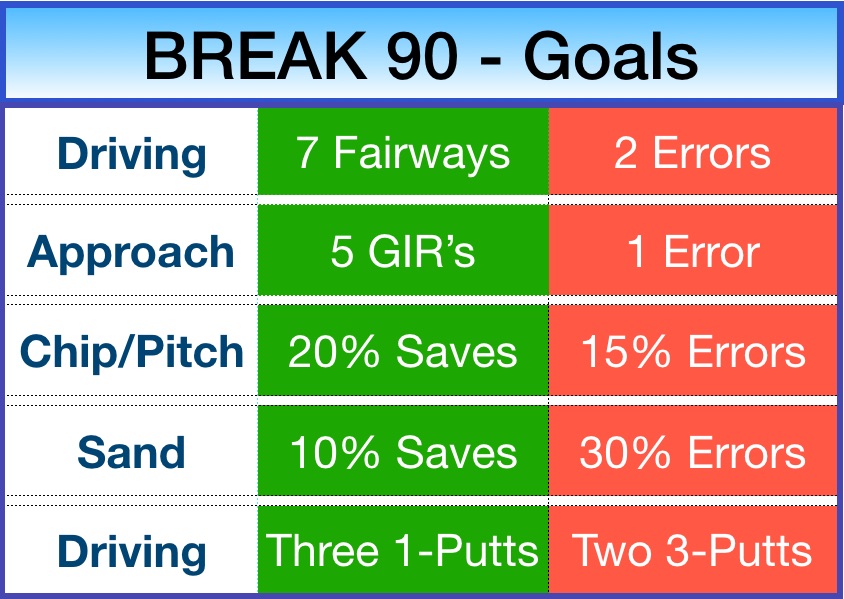Instruction
A modern blueprint to breaking 90

In May of 2017, I contributed an article that generated a lot of interest from GolfWRX readers: “A Modern Blueprint to Breaking 80.” I recently got a call from Jeff Isler, a long-time client who runs a successful golf academy in Dallas. Jeff enthusiastically uses my Strokes Gained analysis program (ShotByShot.com) with all of his students, and also uses my breaking 80 goals as his “road map” with aspiring elite junior golfers. Jeff wondered if a similar roadmap could be created for golfers attempting to break 90. Certainly! In thinking about it, I believe there are also the number of interested golfers in this scoring range in the vast GolfWRX.com world.
Want to break 90? Here is my blueprint
The game is a puzzle and all the pieces fit together. Each round is a mix of good shots, average shots and bad shots or errors. The challenge is to find the piece of your game’s unique puzzle that is your greatest weakness so you can target your improvement time and money on the highest impact area. If you track the simple good and bad outcomes listed below for a few rounds, your strengths and weaknesses will become apparent.
Tee Game or Driving
Goals: Hit 7 fairways, and limit your driving errors to 2 – preferably of the No Shot variety (see Errors below).
Distance: I will ignore this and assume that you are playing from the appropriate tees for your game.
Fairways: Hitting fairways is important as we are all more accurate from the short grass.
Errors: Far more important than Fairways hit is your FREQUENCY and SEVERITY of misses. ShotByShot.com users record THREE types of Driving Errors:
- No Shot: You have missed in a place from which you do not have a normal next shot, requiring some sort of advancement to get the ball back to normal play.
- Penalty: A 1-stroke penalty due to hazard or unplayable lie.
- Lost/OB: Stroke and distance penalty.
Approach Shots
Goals: 5 GIRs and 1 Penalty/2nd (see below)
Penalty/2nd: This means either a penalty or a shot hit so poorly that you are left with yet another full approach shot greater than 50 yards from the hole.
Short Game
(Shots from within 50 yards of the hole)
Chip/Pitch: If you miss 13 greens, you will have at least 10 greenside save opportunities. Your goals should be:
- % Saved: 20% (two saves)
- % Errors: 15% shots that miss the green (approximately three every two rounds)
Sand:
You should have 2 greenside save opportunities. Your goals:
- % Saved: 10%
- % Errors: 30% of your shots miss the green (approximately 1 in every 3 attempts)
Putting
You need 36 putts. Aim for:
- 1-Putts: 3
- 3-Putts: 2
Good luck and please let me know when you are successful!
For a complete Strokes Gained Analysis of your game, log on to: shotbyshot.com.

- LIKE98
- LEGIT12
- WOW2
- LOL7
- IDHT2
- FLOP3
- OB3
- SHANK29
Instruction
The Wedge Guy: The easiest-to-learn golf basic

My golf learning began with this simple fact – if you don’t have a fundamentally sound hold on the golf club, it is practically impossible for your body to execute a fundamentally sound golf swing. I’m still a big believer that the golf swing is much easier to execute if you begin with the proper hold on the club.
As you might imagine, I come into contact with hundreds of golfers of all skill levels. And it is very rare to see a good player with a bad hold on the golf club. There are some exceptions, for sure, but they are very few and very far between, and they typically have beat so many balls with their poor grip that they’ve found a way to work around it.
The reality of biophysics is that the body moves only in certain ways – and the particulars of the way you hold the golf club can totally prevent a sound swing motion that allows the club to release properly through the impact zone. The wonderful thing is that anyone can learn how to put a fundamentally sound hold on the golf club, and you can practice it anywhere your hands are not otherwise engaged, like watching TV or just sitting and relaxing.
Whether you prefer an overlap, interlock or full-finger (not baseball!) grip on the club, the same fundamentals apply. Here are the major grip faults I see most often, in the order of the frequency:
Mis-aligned hands
By this I mean that the palms of the two hands are not parallel to each other. Too many golfers have a weak left hand and strong right, or vice versa. The easiest way to learn how to hold the club with your palms aligned properly is to grip a plain wooden ruler or yardstick. It forces the hands to align properly and shows you how that feels. If you grip and re-grip a yardstick several times, then grip a club, you’ll see that the learning curve is almost immediate.
The position of the grip in the upper/left hand
I also observe many golfers who have the butt of the grip too far into the heel pad of the upper hand (the left hand for right-handed players). It’s amazing how much easier it is to release the club through the ball if even 1/4-1/2″ of the butt is beyond the left heel pad. Try this yourself to see what I mean. Swing the club freely with just your left hand and notice the difference in its release from when you hold it at the end of the grip, versus gripping down even a half inch.
To help you really understand how this works, go to the range and hit shots with your five-iron gripped down a full inch to make the club the same length as your seven-iron. You will probably see an amazing shot shape difference, and likely not see as much distance loss as you would expect.
Too much lower (right) hand on the club
It seems like almost all golfers of 8-10 handicap or higher have the club too far into the palm of the lower hand, because that feels “good” if you are trying to control the path of the clubhead to the ball. But the golf swing is not an effort to hit at the ball – it is a swing of the club. The proper hold on the club has the grip underneath the pad at the base of the fingers. This will likely feel “weak” to you — like you cannot control the club like that. EXACTLY. You should not be trying to control the club with your lower/master hand.
Gripping too tightly
Nearly all golfers hold the club too tightly, which tenses up the forearms and prevents a proper release of the club through impact. In order for the club to move back and through properly, you must feel that the club is controlled by the last three fingers of the upper hand, and the middle two fingers of the lower hand. If you engage your thumbs and forefingers in “holding” the club, the result will almost always be a grip that is too tight. Try this for yourself. Hold the club in your upper hand only, and squeeze firmly with just the last three fingers, with the forefinger and thumb off the club entirely. You have good control, but your forearms are not tense. Then begin to squeeze down with your thumb and forefinger and observe the tensing of the entire forearm. This is the way we are made, so the key to preventing tenseness in the arms is to hold the club very lightly with the “pinchers” — the thumbs and forefingers.
So, those are what I believe are the four fundamentals of a good grip. Anyone can learn them in their home or office very quickly. There is no easier way to improve your ball striking consistency and add distance than giving more attention to the way you hold the golf club.
More from the Wedge Guy
- The Wedge Guy: Golf mastery begins with your wedge game
- The Wedge Guy: Why golf is 20 times harder than brain surgery
- The Wedge Guy: Musings on the golf ball rollback
- LIKE85
- LEGIT13
- WOW6
- LOL1
- IDHT0
- FLOP4
- OB1
- SHANK8
Instruction
Clement: Stop ripping off your swing with this drill!

Not the dreaded headcover under the armpit drill! As if your body is defective and can’t function by itself! Have you seen how incredible the human machine is with all the incredible feats of agility all kinds of athletes are accomplishing? You think your body is so defective (the good Lord is laughing his head off at you) that it needs a headcover tucked under the armpit so you can swing like T-Rex?
- LIKE0
- LEGIT2
- WOW2
- LOL0
- IDHT0
- FLOP0
- OB0
- SHANK2
Instruction
How a towel can fix your golf swing

This is a classic drill that has been used for decades. However, the world of marketed training aids has grown so much during that time that this simple practice has been virtually forgotten. Because why teach people how to play golf using everyday items when you can create and sell a product that reinforces the same thing? Nevertheless, I am here to give you helpful advice without running to the nearest Edwin Watts or adding something to your Amazon cart.
For the “scoring clubs,” having a solid connection between the arms and body during the swing, especially through impact, is paramount to creating long-lasting consistency. And keeping that connection throughout the swing helps rotate the shoulders more to generate more power to help you hit it farther. So, how does this drill work, and what will your game benefit from it? Well, let’s get into it.
Setup
You can use this for basic chip shots up to complete swings. I use this with every club in my bag, up to a 9 or 8-iron. It’s natural to create incrementally more separation between the arms and body as you progress up the set. So doing this with a high iron or a wood is not recommended.
While you set up to hit a ball, simply tuck the towel underneath both armpits. The length of the towel will determine how tight it will be across your chest but don’t make it so loose that it gets in the way of your vision. After both sides are tucked, make some focused swings, keeping both arms firmly connected to the body during the backswing and follow through. (Note: It’s normal to lose connection on your lead arm during your finishing pose.) When you’re ready, put a ball in the way of those swings and get to work.

Get a Better Shoulder Turn
Many of us struggle to have proper shoulder rotation in our golf swing, especially during long layoffs. Making a swing that is all arms and no shoulders is a surefire way to have less control with wedges and less distance with full swings. Notice how I can get in a similar-looking position in both 60° wedge photos. However, one is weak and uncontrollable, while the other is strong and connected. One allows me to use my larger muscles to create my swing, and one doesn’t. The follow-through is another critical point where having a good connection, as well as solid shoulder rotation, is a must. This drill is great for those who tend to have a “chicken wing” form in their lead arm, which happens when it becomes separated from the body through impact.
In full swings, getting your shoulders to rotate in your golf swing is a great way to reinforce proper weight distribution. If your swing is all arms, it’s much harder to get your weight to naturally shift to the inside part of your trail foot in the backswing. Sure, you could make the mistake of “sliding” to get weight on your back foot, but that doesn’t fix the issue. You must turn into your trial leg to generate power. Additionally, look at the difference in separation between my hands and my head in the 8-iron examples. The green picture has more separation and has my hands lower. This will help me lessen my angle of attack and make it easier to hit the inside part of the golf ball, rather than the over-the-top move that the other picture produces.


Stay Better Connected in the Backswing
When you don’t keep everything in your upper body working as one, getting to a good spot at the top of your swing is very hard to do. It would take impeccable timing along with great hand-eye coordination to hit quality shots with any sort of regularity if the arms are working separately from the body.
Notice in the red pictures of both my 60-degree wedge and 8-iron how high my hands are and the fact you can clearly see my shoulder through the gap in my arms. That has happened because the right arm, just above my elbow, has become totally disconnected from my body. That separation causes me to lift my hands as well as lose some of the extension in my left arm. This has been corrected in the green pictures by using this drill to reinforce that connection. It will also make you focus on keeping the lead arm close to your body as well. Because the moment either one loses that relationship, the towel falls.


Conclusion
I have been diligent this year in finding a few drills that target some of the issues that plague my golf game; either by simply forgetting fundamental things or by coming to terms with the faults that have bitten me my whole career. I have found that having a few drills to fall back on to reinforce certain feelings helps me find my game a little easier, and the “towel drill” is most definitely one of them.
- LIKE12
- LEGIT2
- WOW2
- LOL0
- IDHT0
- FLOP2
- OB0
- SHANK8
-

 19th Hole1 week ago
19th Hole1 week agoDave Portnoy places monstrous outright bet for the 2024 Masters
-

 19th Hole2 weeks ago
19th Hole2 weeks agoThings got heated at the Houston Open between Tony Finau and Alejandro Tosti. Here’s why
-

 19th Hole1 week ago
19th Hole1 week agoTiger Woods arrives at 2024 Masters equipped with a putter that may surprise you
-

 19th Hole2 weeks ago
19th Hole2 weeks agoReport: Tiger Woods has ‘eliminated sex’ in preparation for the 2024 Masters
-

 19th Hole4 days ago
19th Hole4 days agoTwo star names reportedly blanked Jon Rahm all week at the Masters
-

 19th Hole3 days ago
19th Hole3 days agoNeal Shipley presser ends in awkward fashion after reporter claims Tiger handed him note on 8th fairway
-

 19th Hole2 days ago
19th Hole2 days agoReport: LIV Golf identifies latest star name they hope to sign to breakaway tour
-

 19th Hole2 weeks ago
19th Hole2 weeks agoAddiction, spinal fusion, and scam artists – Everything Anthony Kim revealed in candid interview with David Feherty





























Myron Miller
May 7, 2019 at 10:33 am
His comment that distance is ignored because you are playing the correct tees. On some courses, I can play the up tees and can still not reach the greens in regulation. I am a super senior (over 70) disabled and cannot consistently hit any longer than 150. Par 3s of 160 or more ( even from the up tees are almost impossible to reach in 1). Par 4s of 330 or more (and I’ve seen 350-370 a number of times) cannot be reached in two.
With highly exceeding the rest of his suggestions, one cannot score below 100 period. Personally I can break 90 most of the time, if my approach game is reasonably decent and my short game is pretty good (at least 70% from 20 yards on the green within 20 yards). And I only mishit 2-3 fairway woods. Due to my short driver, I hit a lot of fairway woods as my second shot (and I’m playing the up tees). His suggestions to me are a load of crap. I could never break 110 or 120 if i followed them.
Bob Jones
May 6, 2019 at 5:41 pm
Are we talking to people who are on the verge of breaking 90 but never do? If that is the case, I would say learning how to play the game better will do it. Golf is more than hitting good shots; it’s also about hitting the right shot at the time. Leaving the driver home should help, too.
Johnny O
May 6, 2019 at 3:58 pm
I shoot in the 90s and I keep stats: tee shots, approach shots, GIR, putts, dropped shots and eff-ups. Dropped shots are penalties, like OB, re-tees, water. Eff-ups include the dropped shots and other duffs and stupid hits that cost a whole shot. I can tell you that when I get some sleep and play well and shoot in the 80s, the key stat is the eff-ups. A reduction in stupid mistakes, shots I’d never hit again if I placed another ball and repeated the attempt. I don’t suddenly become a dead straight driver or genius green reader. Yeah, if you have a bunker phobia, then you know you need to work on that. But if you’re just generally ordinary, then reducing errors will also get those other target numbers into line. 7 to 9 good drives and 5 or 6 GIRs sounds about right.
dj
May 5, 2019 at 5:47 pm
“If you think 18 handicappers have the patience or commitment to do a rote breakdown of their round by sifting through GIRs, penalties off the tee, and 3 putts.”
Anyone that wants to improve should keep stats to know where to improve. I’m not 100% in agreement with the topic but believe GIR are king. If you don’t know where you are losing strokes, you’ll never improve. Most people have a false sense of strokes lost/gained.
Leezer99
May 5, 2019 at 12:18 pm
No offense but this is a joke of a blueprint. The Brady Riggs Breaking 80 plan actually gives you a step by step plan over time to improve your game.
Eric
May 5, 2019 at 11:37 am
This is not the best way to break 90. If you think 18 handicappers have the patience or commitment to do a rote breakdown of their round by sifting through GIRs, penalties off the tee, and 3 putts.
A more practical approach includes hitting the shot you know you’re capable of and never putting yourself to a difficult decision on the subsequent shot.